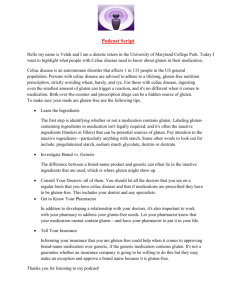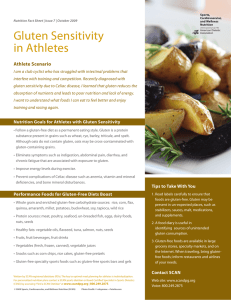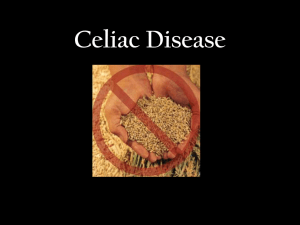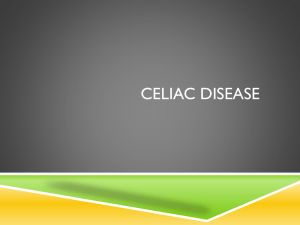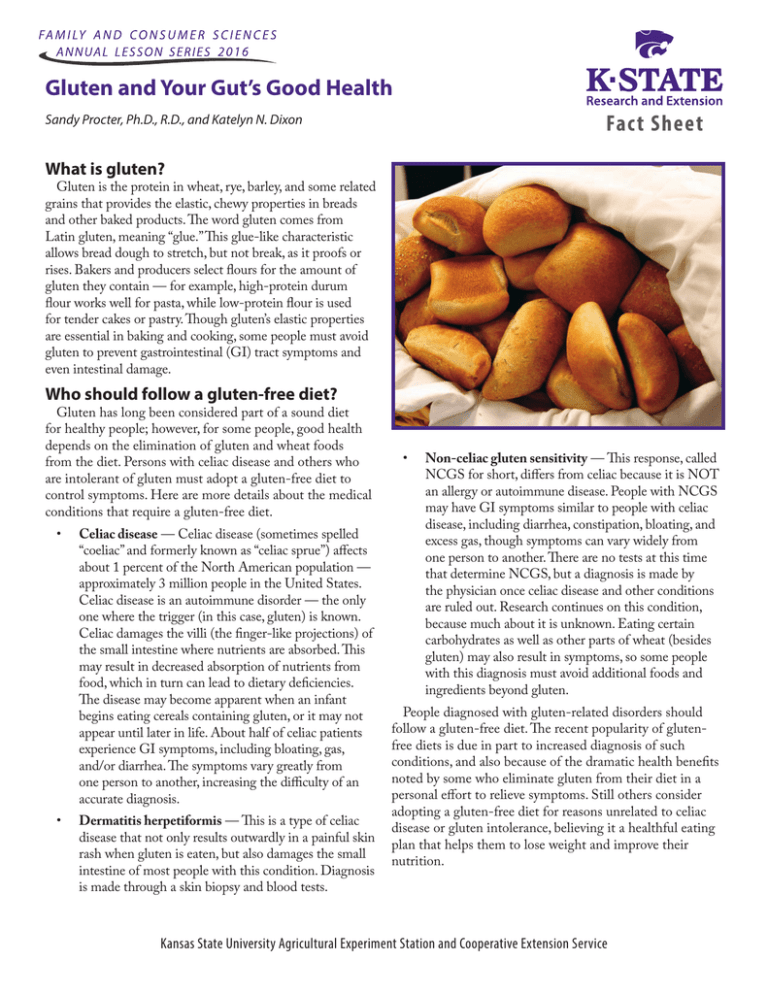
Gluten and Your Gut’s Good Health
Fact Sheet
Sandy Procter, Ph.D., R.D., and Katelyn N. Dixon
What is gluten?
Gluten is the protein in wheat, rye, barley, and some related
grains that provides the elastic, chewy properties in breads
and other baked products. The word gluten comes from
Latin gluten, meaning “glue.” This glue-like characteristic
allows bread dough to stretch, but not break, as it proofs or
rises. Bakers and producers select flours for the amount of
gluten they contain — for example, high-protein durum
flour works well for pasta, while low-protein flour is used
for tender cakes or pastry. Though gluten’s elastic properties
are essential in baking and cooking, some people must avoid
gluten to prevent gastrointestinal (GI) tract symptoms and
even intestinal damage.
Who should follow a gluten-free diet?
Gluten has long been considered part of a sound diet
for healthy people; however, for some people, good health
depends on the elimination of gluten and wheat foods
from the diet. Persons with celiac disease and others who
are intolerant of gluten must adopt a gluten-free diet to
control symptoms. Here are more details about the medical
conditions that require a gluten-free diet.
•
•
Celiac disease — Celiac disease (sometimes spelled
“coeliac” and formerly known as “celiac sprue”) affects
about 1 percent of the North American population —
approximately 3 million people in the United States.
Celiac disease is an autoimmune disorder — the only
one where the trigger (in this case, gluten) is known.
Celiac damages the villi (the finger-like projections) of
the small intestine where nutrients are absorbed. This
may result in decreased absorption of nutrients from
food, which in turn can lead to dietary deficiencies.
The disease may become apparent when an infant
begins eating cereals containing gluten, or it may not
appear until later in life. About half of celiac patients
experience GI symptoms, including bloating, gas,
and/or diarrhea. The symptoms vary greatly from
one person to another, increasing the difficulty of an
accurate diagnosis.
Dermatitis herpetiformis — This is a type of celiac
disease that not only results outwardly in a painful skin
rash when gluten is eaten, but also damages the small
intestine of most people with this condition. Diagnosis
is made through a skin biopsy and blood tests.
•
Non-celiac gluten sensitivity — This response, called
NCGS for short, differs from celiac because it is NOT
an allergy or autoimmune disease. People with NCGS
may have GI symptoms similar to people with celiac
disease, including diarrhea, constipation, bloating, and
excess gas, though symptoms can vary widely from
one person to another. There are no tests at this time
that determine NCGS, but a diagnosis is made by
the physician once celiac disease and other conditions
are ruled out. Research continues on this condition,
because much about it is unknown. Eating certain
carbohydrates as well as other parts of wheat (besides
gluten) may also result in symptoms, so some people
with this diagnosis must avoid additional foods and
ingredients beyond gluten.
People diagnosed with gluten-related disorders should
follow a gluten-free diet. The recent popularity of glutenfree diets is due in part to increased diagnosis of such
conditions, and also because of the dramatic health benefits
noted by some who eliminate gluten from their diet in a
personal effort to relieve symptoms. Still others consider
adopting a gluten-free diet for reasons unrelated to celiac
disease or gluten intolerance, believing it a healthful eating
plan that helps them to lose weight and improve their
nutrition.
Kansas State University Agricultural Experiment Station and Cooperative Extension Service
How can I know if I would benefit from a
gluten-free diet?
Many people today are asking this question, as facts and
myths surrounding a gluten-free diet abound. If you believe
you suffer from celiac or a related disease, it is important that
you see your health-care provider before starting a glutenfree diet. Since celiac disease is determined by blood tests and
a biopsy of the small intestine, beginning a gluten-free diet
before testing could interfere with an accurate diagnosis.
While it is not considered dangerous to eat gluten-free, it
can be overly restrictive and unnecessarily costly. A glutenfree diet has not been shown to be an effective weight loss
diet. Dieters who choose to follow a gluten-free diet for
reasons other than symptom relief may needlessly limit
important nutrients such as iron, folic acid, and other B
vitamins.
My doctor told me I have a wheat allergy.
Is a gluten-free diet right for me?
No. Different from both celiac disease and NCGS, wheat
allergy is an allergic reaction to wheat or its components,
such as starches, proteins, and even fat. A true wheat
allergy will bring about near-immediate or slightly delayed
symptoms following a wheat-containing meal. Like other
allergies, wheat allergy symptoms are often respiratory in
nature (nasal congestion, wheezing, watery eyes) but may
escalate to breathing difficulty and shock. People diagnosed
with wheat allergy need to avoid foods that contain wheat
ingredients. It is important to note that some gluten-free
foods may contain other wheat components, especially in
Europe and the United Kingdom.
In short, wheat allergy and gluten intolerance are
two completely different problems with similar, but not
identical, treatments.
Where is gluten found?
Gluten is found in wheat and related grains, particularly
rye and barley. Oats, though technically gluten free, are
frequently contaminated during processing and should be
avoided on a gluten-free diet unless the package is labeled
“gluten-free.” The following chart identifies grains and
thickeners containing gluten, and starches and flours that
are gluten free.
In 2013, the U.S. Food and Drug Administration
published a new regulation defining the term “glutenfree” for voluntary food labeling. The federal definition
standardizes the meaning of gluten-free claims across the
food industry and allows people requiring the special diet
to make healthful food choices with confidence. When
“gluten-free” is used on the label, a food is required to
contain less than 20 parts per million of gluten. The rule
also requires foods claiming “no gluten,” “free of gluten” and
“without gluten” to meet the definition for “gluten-free.”
Gluten may also be used in some prescription drugs,
as well as some cosmetics, multivitamin, and mineral
supplements. If you require a gluten-free diet, you will
want to ask the pharmacist if your prescribed medications
contain gluten. Products available over-the-counter are
required to be labeled so consumers can determine if they
contain gluten.
Gluten-Containing Grains/
Thickeners
Gluten-Free Grains/
Thickeners
Wheat
Corn
Kamut
Rice
Spelt
Tapioca (cassava)
arley (malt, including malt
B
extract, malt vinegar)
Amaranth
Rye
Buckwheat
Farro
Arrowroot
Oats*
Millet
T riticale (a cross between
wheat and rye)
Montina
Brewer’s yeast
Wheat starch (not processed)
Lupine
Flax
Quinoa
Soy
Sorghum
Taro
Teff
Chickpea (gram flour)
*Technically, oats are gluten free but are often contaminated during
processing.
2
K-State Research and Extension — Gluten and Your Gut’s Good Health, Fact Sheet
My doctor advised me to follow a glutenfree diet. What do I do?
At first, following a gluten-free diet may be challenging.
You may initially think of all the foods you must avoid and
feel overwhelmed with the effort required to identify the
many sources of gluten you encounter each day. Instead of
feeling deprived, you may want to focus on all the foods you
CAN eat — those naturally containing no gluten, as well as
the many gluten-free products available today.
If you are just beginning to follow a gluten-free diet,
it would be helpful to visit with a registered dietitian
nutritionist (RDN) who can answer your questions and
advise you on ways to exclude gluten, while maintaining a
healthful diet.
How do I cook for a gluten-free diet?
Although it sounds like a huge task, and it IS a very
important task, you will probably find that many foods you
cook are naturally gluten-free. Begin by listing those foods;
they will be anchors in your meal planning. Plain foods —
without sauces, breading, or coating — are great places to
start. For example, you might consider roast beef or grilled
chicken with baked or mashed potatoes, steamed carrots,
mixed green vegetable salad, and fresh berries. Without
added coating, croutons, or cookies, this meal is gluten
free, naturally. The challenge increases when foods typically
containing gluten, such as pasta, bread, other baked goods
and desserts, and many processed items, are added into the
menu. These foods often contain gluten, and the key will be
the food label.
You will want to sharpen your label-reading skills, and
make label reading a priority for your health. For those
following a gluten-free diet, it is essential to read product
labels of foods not labeled “gluten-free” each time you shop.
Gluten may be hidden in unexpected places (for example
in one brand of pasta sauce, but not in one that looks very
similar) and product recipes may change from one purchase
to the next.
Beware of cross-contact! Cross-contact can occur
whenever a gluten-free food comes in contact with a food
that contains gluten. Similar to how germs can be spread
from dirty hands to clean food, gluten-free foods may
“pick up” gluten anywhere from field to factory to fork. For
example, a gluten-free grain might be grown next to a field
of wheat, barley, or rye. A factory must follow good practice
to prevent gluten-free foods from contamination by glutencontaining foods. Even at home, it is important to keep
gluten-free foods separate from those containing gluten
during storage, cooking, and serving.
in foods labeled gluten-free as long as the final product
contains less than 20 parts per million (ppm) of gluten.
Examples of this type of ingredient include wheat starch,
modified food starch (wheat), and ingredients that may
be made from wheat starch, including dextrin (wheat),
maltodextrin (wheat), glucose syrup (wheat), and caramel
(wheat). The FDA’s gluten-free labeling rule states that a
food labeled gluten-free that also contains the word “wheat”
in the ingredients label must also have this statement: “The
wheat has been processed to allow this food to meet the
Food and Drug Administration requirements for glutenfree foods.”
If you need some assistance at the grocery store, you may
want to investigate the list of available apps for your phone
or tablet. Look for those with high ratings from users and
recent content updates. There are many options and the
field of available, allowable foods changes constantly.
Can I safely eat at a restaurant or a friend’s
home with my gluten-free diet?
While eating out may be challenging, a gluten-free diet
should not keep you at home. Plan ahead. If you know
the restaurant you will visit, call or check online for their
gluten-free options. Many restaurants now offer a glutenfree menu. Remember to ask if cross-contact is likely (are
corn tortilla chips fried in the same fryer as flour taco
shells? Is the grill used for foods that are not gluten-free,
such as buns or breaded products?).
If visiting a friend’s home, let your host know ahead of
time about your dietary restrictions. Offer to bring along a
gluten-free dish that everyone can enjoy.
What else do I need to know?
Less is best. If you or someone you know has been
diagnosed with celiac disease, you may think that “just a
little won’t hurt” when it comes to breaking your glutenfree diet. Wrong! Eating even small amounts of gluten can
damage the small intestine. And the amount of gluten in a
regular slice of wheat bread is 7,000 times that in a slice of
gluten-free bread — hardly “just a little.”
Some products are labeled gluten-free but contain the
word “wheat” in the ingredient label. This is allowed,
because some wheat-based ingredients may be included
K-State Research and Extension — Gluten and Your Gut’s Good Health, Fact Sheet
3
Family matters. First- and second-degree relatives of
people diagnosed with celiac disease are more likely than
the general population to have celiac disease. They should
discuss the need for testing for celiac disease with their
health-care provider before starting a gluten-free diet.
Where can I turn for more information?
If your health-care provider advises you or a family
member to follow a gluten-free diet, there are many
reputable resources available. Here are some:
Academy of Nutrition and Dietetics: www.eatright.org
Go to this site to search for information on celiac disease
and also to find a registered dietitian nutritionist in your
area.
Celiac Now: www.celiacnow.org
This site offers instruction on managing celiac disease and
living with a gluten-free diet. Topics are addressed on three
levels (from introductory to complex) to match the reader’s
interest and understanding.
Celiac Disease Foundation: www.celiac.org
The mission of the foundation includes advocacy and
awareness, and this site provides educational information to
help celiac disease patients and those who support them.
Celiac Disease, 2nd Edition: A guide to living with gluten
intolerance (2014) by Sylvia Llewelyn Bower, RN; Mary
Kay Sharrett, SM, RD, LD, CNSD; and Steve Plogsted,
PharmD.
This book discusses how to safely alter the diet, manage
symptoms, and adjust to living gluten free. Available at
Amazon.
Apps for gluten-free living:
Is That Gluten Free? by Garden Bay Software. Available
on iTunes.
References:
Adams, J. Willem-Karel Dicke: Pioneer in gluten-free diet in the
treatment of celiac disease. 2010. Accessed at http://www.Celiac.
com/articles/22013/l/Willem-Karel-Dicke-Pioneer-in-Gluten-freeDiet-in-the-treatment-of-Celiac-Disease/Page1.html on January 29,
2015.
Di Sabatino, A, Corassa, GR. “Nonceliac gluten sensitivity:
Sense or sensibility?” Ann Intern Med. 2012;156:309-311.
Gaesser GA, Angadi SS. “Gluten-free diet: Imprudent
dietary advice for the general population?” J Acad Nutr Diet.
2012;112(9):1330-1333.
McKindra, L. Agricultural Communications Services,
Oklahoma State University Division of Agricultural Sciences and
Natural Resources. Gluten-free diets not for everyone. Accessed at
http://www.dasnr.okstate.edu/Members/leilana.mckindra-40okstate.
edu/gluten-free-diets-not-for-everyone on February 5, 2015.
Office of the Federal Register. Vol. 78, 150, 47154-47179. Food
labeling; gluten-free labeling of foods. 08/05/2013. https://www.
federalregister.gov/articles/2013/08/05/2013-18813/food-labelinggluten-free-labeling-of-foods. Accessed on March 9, 2015.
Riddle, MS, Murray, JA, Porter, CK. “The incidence and
risk of celiac disease in a healthy US adult population.” Am J
Gastroenterol 2012;107:1248-1255.
Thompson, T. Celiac disease nutrition guide, 3rd ed. Academy of
Nutrition and Dietetics. 2014.
Volta, U, Caio, G, Tovoli, F, DeGiorgio, R. “Non-celiac gluten
sensitivity: questions still to be answered despite increasing
awareness.” Cellular & Molecular Immunology 2013; 10, 383-392.
Acknowledgements
Special thanks to Janice Hermann, Ph.D., R.D., Oklahoma
State University Extension, and Nozella Brown, Ed.D, Family
and Consumer Sciences Agent in Wyandotte County, K-State
Research and Extension, for their careful and helpful reviews of
this lesson.
Find Me Gluten Free, by Gluten Free Classes, LLC.
Available on iTunes.
Glutenology – Gluten Free Guide, by David Ramsey.
Available on iTunes.
Publications from Kansas State University are available at:
www.ksre.ksu.edu
Kansas State University Agricultural Experiment Station and
Cooperative Extension Service
Publications are reviewed or revised annually by appropriate faculty to
reflect current research and practice. Date shown is that of publication or
last revision. Contents of this publication may be freely reproduced for
educational purposes. All other rights reserved. In each case, credit Sandy
Procter, Ph.D., R.D., and Katelyn N. Dixon, Gluten and Your Gut’s Good
Health, Fact Sheet, Kansas State University, July 2015.
K-State Research and Extension is an equal opportunity provider and
employer. Issued in furtherance of Cooperative Extension Work, Acts of
May 8 and June 30, 1914, as amended. Kansas State University, County
Extension Councils, Extension Districts, and United States Department
of Agriculture Cooperating, John D. Floros, Director.
MF3226 July 2015

